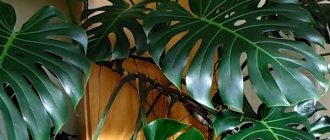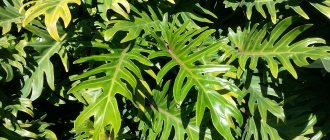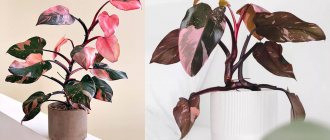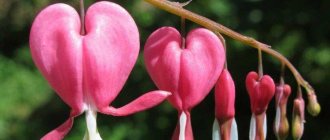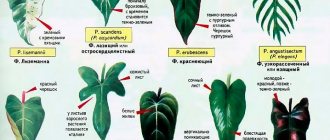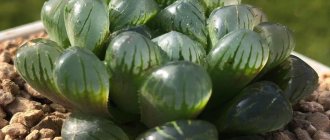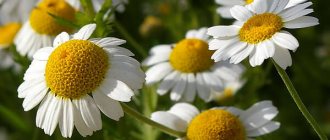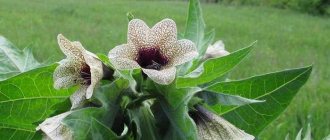Description and photo
A decorative vine that perfectly purifies indoor air. Fast growing, shade tolerant. The stems of the flower are densely dotted with green, slightly wrinkled, heart-shaped leaves. Young philodendron leaves are thin, delicate, and bronze in color.
Over time, the leaf blade darkens, acquiring a rich green color. The leaf size can reach 10-15 cm in length and about 8-10 cm in width. The stem of the plant is equipped with clinging aerial roots.
Secret No. 4. Add a couple of degrees to the minimum temperature
In recommendations for growing philodendrons you can often find a minimum permissible temperature of 13 degrees. It is better not to bring the situation to such a decline. Limit the winter temperature range to just 16 degrees. And then you will prevent most of the problems and difficulties that may arise in growing philodendrons.
As for the air temperature from spring to autumn, room temperatures will be comfortable for philodendrons (from 20 to 25 degrees). But higher rates are not. In order for philodendrons to remain highly decorative in the heat, you will have to make efforts to control more abundant watering and increase air humidity. But the main thing is to protect the plants from temperature changes. Do not place any heating devices near philodendrons, protect the plants from air conditioning and even ventilation in cold weather.
Just by stabilizing the temperature and monitoring the minimum indicators, you guarantee that the leaves on your philodendron will not become smaller, and growth and development will occur evenly.
Philodendron gloriosum
Varieties
Brazil (p. Scandens Brazil)
The most common representative. The stem is equipped with wide heart-shaped leaves with pointed tips. The leaf blade is green with expressive yellow spots and stripes.
Important! With a lack of lighting, the plant stretches and the leaves become smaller.
Mikans (p. Scandens Micans)
The most unpretentious representative. A small, thin-trunked vine, suitable for indoor growing and vertical gardening.
Characteristic are velvety, dark green leaves with a burgundy tint, heart-shaped.
Secret No. 1. Individual approach
The main, and perhaps the most reliable advice that can be given (and received) when buying a philodendron is to be sure to study all the features of a particular species and even variety. After all, some varieties of these plants are more hardy than other varieties. And the “scatter” in the requirements for growing conditions and care for different types of philodendrons can be very large. Some plants are better adapted to indoor environments or specific locations than others.
Thus, shade tolerance is an excellent characteristic of the ivy-leaved Philodendron ( Philodendron hederaceum
)
- climbing philodendron ( Philodendron hederaceum
var.
hederaceum
), which can be used for complete landscaping in the back of the room.
The blushing philodendron can also keep it company , but other species grow better in a scattered light place and in partial shade.
Philodendron bipinnatifidum - with its almost meter-long beautifully cut leaves - is not the best candidate for small rooms and apartments. In any case, when purchasing, it is worth checking how demanding your philodendron is regarding air humidity, what maximum size it can reach, and whether it is easy to control. With this check you will save yourself from dozens of problems.
Climbing Philodendron, or Clinging Philodendron (Philodendron hederaceum var. hederaceum)
Reddish Philodendron, or Blushing Philodendron (Philodendron erubescens)
Philodendron bipinnatifidum, or Philodendron bipinnatifidum
Peculiarities
Scandens is the most shade-tolerant type of philodendron. Low branching, climbing. However, it requires sunlight to develop. Has long and flexible shoots. The leaf plate is heart-shaped with a glossy sheen.
Bloom
Inflorescences can be seen when growing philodendron in a winter garden or greenhouse (it does not bloom at home).
The type of inflorescence is small cobs, wrapped in a blanket-hood. A play of color palettes from white to violet.
- Flowering time. Occurs in early spring or summer.
- Fetus. A berry, usually white, containing very small seeds inside.
Possible harm
Philodendron sap contains calcium oxalate, which is toxic to small animals. Its effects are harmful to human skin and mucous membranes, especially for children. When working with the plant, it is necessary to protect your hands from getting juice with gloves. It is also worth thoroughly washing garden tools after working with philodendron.
Climbing Philodendron exhibits fast growth and beautiful foliage and does not require special conditions. Due to its shade tolerance, the plant is suitable for apartments with problematic natural light. Requires increased caution in homes with small children and pets.
Landing
Choosing a pot
The size of the container should be slightly larger than the root system of the flower (radius about 10-12 cm). There must be a drainage hole and drainage.
A support corresponding to the length of the vine is installed in the center of the pot (the support should not be completely smooth).
The soil
The best option is fertile light soil for decorative deciduous crops. It is possible to use a universal soil mixture for potted plants. Scandens Micans can be grown using hydroponics.
Landing rules
The favorable period is the beginning or middle of spring.
- Drainage is placed at the bottom of the pot, soil is poured on top.
- The roots of the plant are completely covered with soil (they do not cover the growing point).
- Water the plant abundantly.
Air layering:
- pre-moisten the soil;
- layering in the soil, fixed with wire or pins;
With a cutting or a leaf with a “heel”:
Planting material is placed in cold water. After the roots appear, they are planted in the soil.
- placed in moist soil;
- create greenhouse conditions - cover with a cut-off plastic bottle with an open neck;
- after 2-3 weeks they are planted in separate permanent pots.
Reproduction
The presence of aerial roots makes it easy to solve the question of how to propagate the plant. The simplest way is cuttings. Breeders use seeds, but the process takes much longer.
Cuttings
The plant takes root best in the warm season at temperatures up to +30°C.
To do this, perform the following actions:
- Cut off a stem with 2-3 internodes below the aerial root. Treat the cut with coal powder. If you only have a cutting without roots to work with, you need to put it in a container with water and wait for the root to appear.
- Plant the cuttings in prepared, disinfected soil.
- Cover the cutting with a transparent bag or glass jar to maintain high humidity inside. Ventilate every 2 days, if necessary, moisten with warm, settled water.
- The cover is removed after the appearance of new leaves, which indicate successful rooting.
Did you know? Philodendron is translated from ancient Greek as “I love the tree” and describes the way it exists in its native environment.
Seeds
Seeds are sown in spring.
The sequence of the process is as follows:
- Place the seeds into the prepared disinfected mixture to a depth of 5 mm.
- Moisten the soil by spraying with warm, settled water from a spray bottle.
- Cover the crop with glass or transparent film and place the box in a warm place.
- Maintain high humidity in the container and wait for seedlings to appear in about 1.5 months.
- After the first true leaves appear, plant the seedlings in separate containers.
Home care
Temperature
In summer the temperature in the room is not higher than 22-23°C, in winter – not lower than 15-16°C. Afraid of drafts.
Lighting
The flower loves bright, diffused light throughout the day, but can also grow in shade. Direct sunlight can cause leaf burns.
Grows well in artificial light. Prefers north-east or north-west windows.
Watering
Prefers moderate, gentle watering with settled water. The water from the pan is immediately drained.
In the autumn-winter period, watering is reduced, but the roots are monitored for drying out.
In summer, the plant is sprayed or wiped with a damp cloth.
Top dressing
Mineral or organic fertilizers are applied monthly - from early spring to early autumn. You can use complex fertilizers for decorative deciduous plants.
Trimming
Regular pruning of old shoots is necessary - this promotes luxurious growth of the plant. New shoots appear at the cutting site.
Transfer
Produced in late March - early April. Young plants are replanted every year, adults - once every 3-4 years. The size of the pot is 5-7 cm larger than the previous one. Use new drainage.
Handle the plant if the roots are strongly intertwined. Within 2 weeks, the plant must be sufficiently shaded and excessive watering should be avoided.
Flowering period
Philodendron Scandens does not bloom at home. The absence of flowering in the greenhouse indicates insufficiently comfortable conditions for keeping the plant.
Philodendron climbing
Philodendron climbing is the best option for an apartment. The development of this species does not require much space, and therefore it can be grown like any hanging plant in a hanging pot. An unpretentious option.
What is Philodendron
Description of the plant
Perennial plant of the Araceae family. Habitat in the wild is the tropics of Latin America, Australia, Mexico. Depending on the variety and type of plant, its appearance may differ. The branched rhizome of this vine is superficial. Each internode forms roots on its own. The finest hairs sprout and become attached to tree trunks or walls.
For your information! The long, thin stem can reach 2-3 m. Part of the shoot is gradually covered with bark, so the flower does not need additional support, since the wood is quite dense.
climbing view
Diseases and pests
- Stem rot. The reason is excessive watering. Control measures: trim the trunk and re-root.
- Bacterial spotting. The reasons are increased humidity and ambient temperature. Control measures: removal of damaged areas. Fungicide treatment.
- Scale insects, thrips, mealybugs, spider mites. Control measures: treatment with soap solution, karbofos, acaricides.

